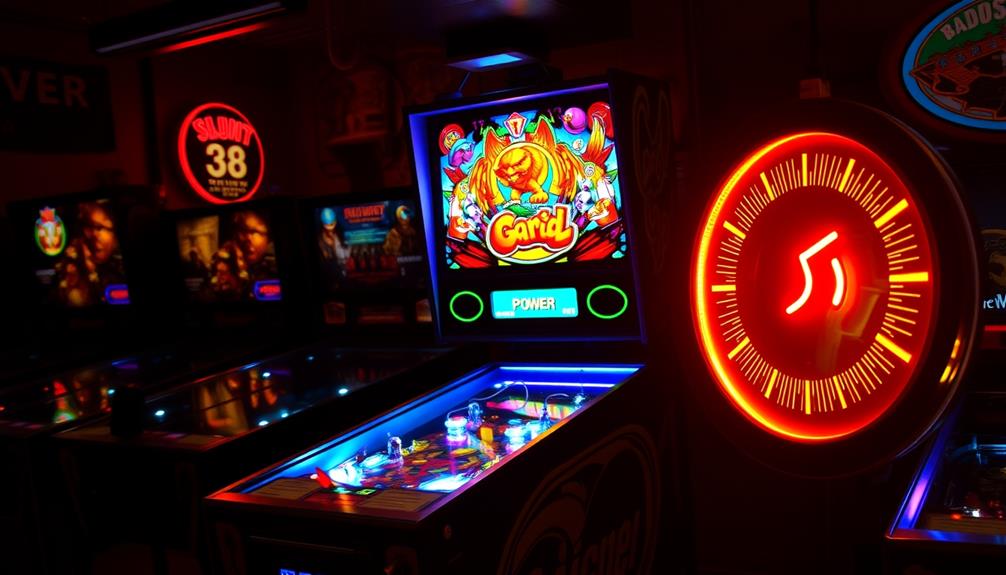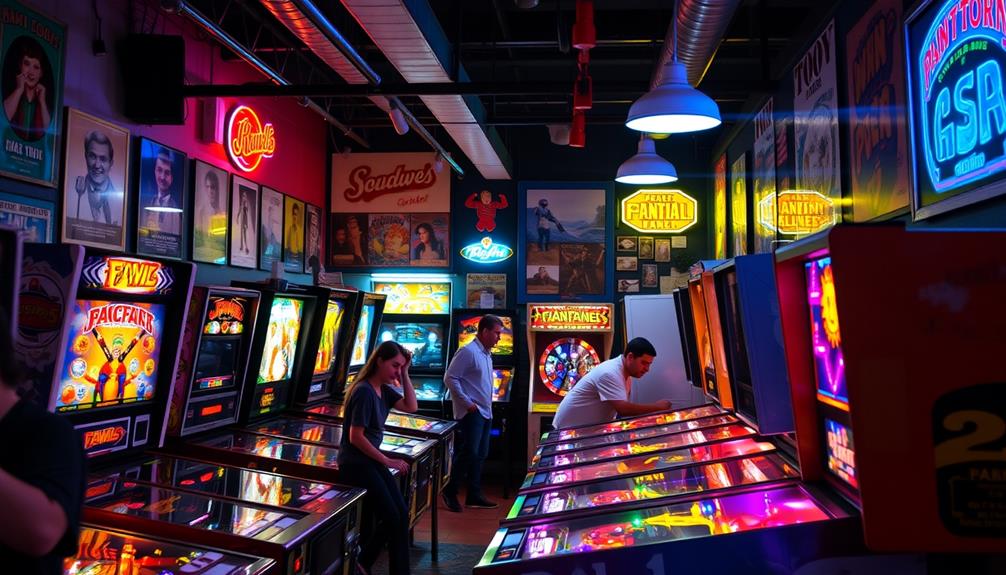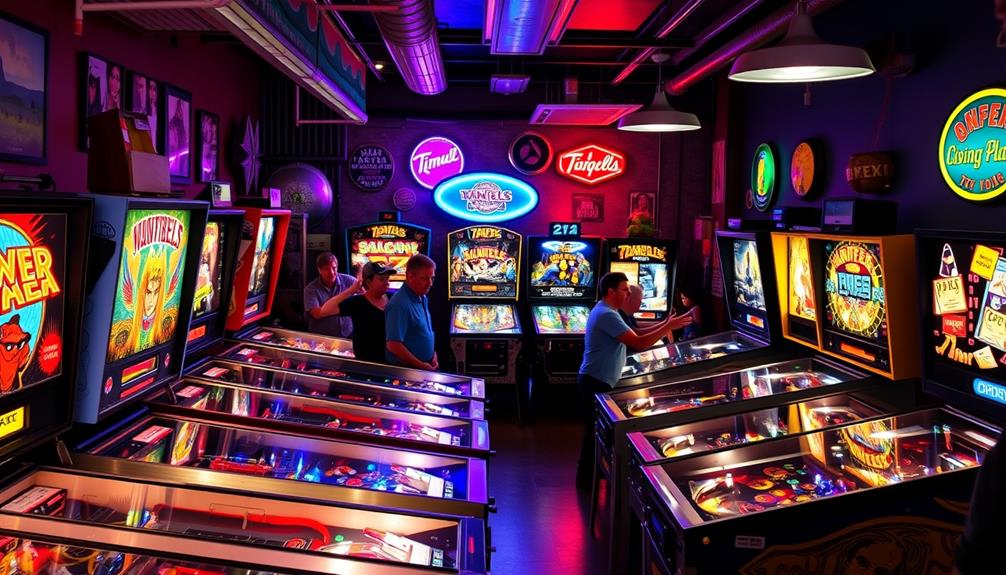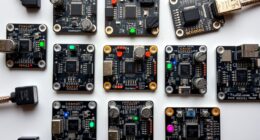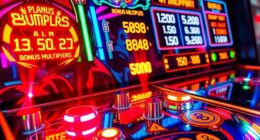A typical pinball machine typically uses between 200 to 360 watts while in use, but when it is not being played, the energy consumption drops to around 100 watts, especially if it is equipped with LED lighting. During regular gameplay, you can expect an average power consumption of about 300 watts. It is worth noting that switching from incandescent to LED bulbs can result in even greater energy savings. Additionally, the significant increase in power usage during gameplay can impact your electricity expenses. Interested to learn more about how these factors can affect your costs? There is much more to discover about pinball power consumption.
Key Takeaways
- Average power consumption for pinball machines ranges from 245 to 350 watts during gameplay.
- Idle power usage typically falls around 100 watts when using LED lighting.
- Gameplay can cause power spikes to approximately 360 watts on a 120V line.
- Standard LED machines cost about $0.576 per day to operate, significantly saving energy.
- High-demand games may draw more current, with some machines peaking around 600 watts.
Overview of Power Consumption
Understanding the power consumption of a pinball machine reveals the intricate balance between enjoyment and energy use. On average, pinball machines consume between 245 and 350 watts, but when you're in the heat of gameplay, that number can spike even higher. Operating on a 120V line, these machines typically draw around 3 amps, translating to roughly 360 watts.
For those who enjoy gaming and want to manage energy use more effectively, similar principles apply to best vacuums for dust removal that emphasize efficiency and performance.
While you might think power usage drops considerably when the machine's idle, it can still be notable. Fully LED-equipped pinball machines can draw around 100 watts even when not in play. During gameplay, average power usage fluctuates between 200W and 250W, depending on the specific machine and its components.
If you're considering saving on energy costs, shifting to LED lighting can make a big difference. For instance, switching out 50 incandescent bulbs for LEDs could save about 270 watts.
This change not only enhances your gaming experience with better lighting but also helps you manage your power consumption more efficiently. By understanding these figures, you can enjoy your pinball games while being mindful of the energy you're using.
Power Supply Specifications

When choosing a power supply for your pinball machine, you'll want to focus on voltage and current ratings that match your setup.
Understanding the importance of proper investment regulations can help in making informed decisions about equipment costs.
For instance, a typical setup needs a 12V supply, like the Mean Well LRS-150-12, which delivers 12.5A.
It's crucial to select power supplies that not only meet these specifications but also account for inrush current to avoid system overload.
Recommended Power Supplies
Selecting the right power supply for your pinball machine is essential to confirm peak performance and longevity. A well-chosen power supply guarantees your machine operates efficiently and can handle the demands of gameplay without compromising safety.
Additionally, understanding the importance of quality assurance in software development can be beneficial when integrating technology into your pinball machine, as it helps enhance user satisfaction through reliable performance quality assurance in software development.
Here are some recommended power supplies for your pinball machine:
- Mean Well RSP-500-48: Delivers 48V DC at 10.5A, ideal for machines running on 48V.
- Mean Well LRS-150-12: Offers 12V at 12.5A, perfect for various components.
- Mean Well LRS-100-12: A solid choice with 12V at 8.5A for lower power needs.
- Inrush Current Consideration: Keep in mind that a 48V supply might experience inrush currents of 20A at 115VAC and 40A at 230VAC, which can affect stability.
Switching power supplies (SMPS) are your best bet due to their efficiency, smaller size, and cooler operation compared to linear supplies.
When you select your power supply, confirm it can handle a maximum sustained current of 7A for the FAST platform. This attention to detail will help keep your pinball machine running smoothly for years to come.
Voltage and Current Ratings
In the world of pinball machines, voltage and current ratings are fundamental for guaranteeing ideal performance. Most pinball machines operate on a standard voltage of 120V, drawing around 2.5 amps, which equates to approximately 300 watts during your gameplay sessions.
However, the power supply specifications require a 12V output, with recommended supplies providing between 8-13 amps to meet the machine's demands. As the integration of technology expands, understanding the AI Software Engineer Jobs aspect can also be beneficial, as these professionals often work on innovative projects that enhance overall system functionality.
Be aware that some machines can peak at around 600 watts, depending on their lighting and mechanical components. In certain scenarios, they can even consume up to 1150 watts. This variability makes understanding the current ratings (amps) essential.
Each FAST Pinball power channel has a maximum capacity of 7 amps, so it's critical to match your power supply capacity carefully to avoid overloads.
Switching power supplies (SMPS) are the preferred choice for these machines, thanks to their efficiency and ability to handle variable input voltages. Often, these supplies are rated at 48V for specific components, which helps guarantee your pinball machine operates smoothly and reliably.
Always double-check your voltage and current ratings to keep the game running without a hitch!
Impact of LED Lighting

Over the last few years, the shift to LED lighting in pinball machines has proven to be a game changer for energy efficiency. By swapping out incandescent bulbs for LEDs, you can save approximately 270 watts per machine.
This significant reduction in power consumption translates to lower energy costs, which is essential for operators and enthusiasts alike. Additionally, using energy-efficient components is beneficial for overall sustainability, similar to how daily consumption may impact kidney stone prevention with certain dietary choices.
Here are some key benefits of LED lighting in pinball machines:
- Lower Power Consumption: LEDs use only 0.1 – 0.2 watts each compared to 6 watts for incandescent bulbs.
- Cost Savings: A full conversion typically costs between $170 to $220, but the energy savings can offset this investment over time.
- Reduced Heat Generation: LEDs generate less heat, minimizing maintenance needs and extending the lifespan of your machine's components.
- Cooling Efficiency: The cooler operation can lead to lower air conditioning costs, especially in environments with multiple machines.
Current Requirements and Ratings
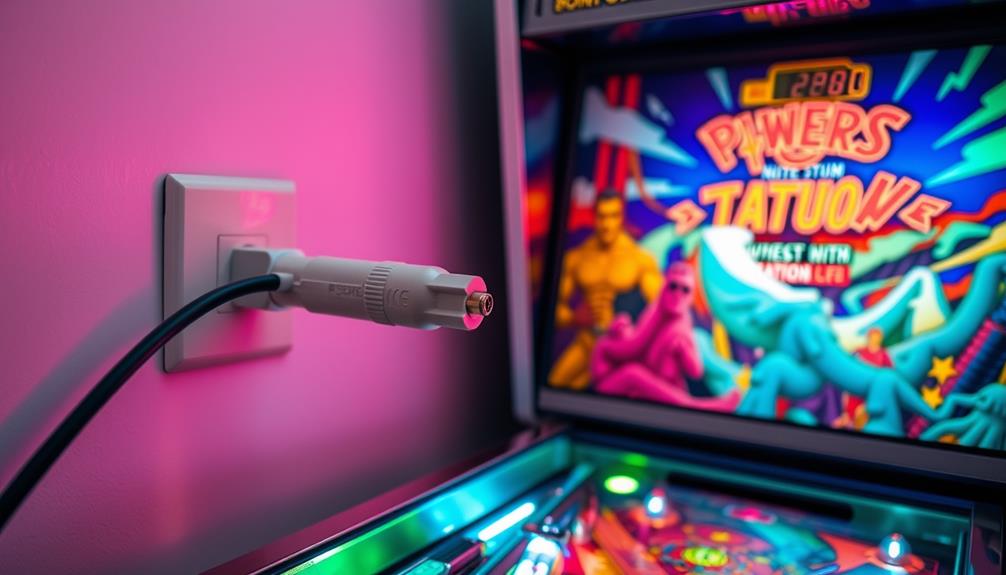
Understanding the current requirements and ratings of pinball machines is fundamental for guaranteeing they operate efficiently and reliably. Typically, a pinball machine draws about 2.5 amps at 120 volts, leading to a power consumption of around 300 watts. However, this can vary greatly based on the machine's components and features. Pinball machine power usage can also be affected by additional features such as LED lighting, solenoids, and electronic displays. It is important to consider these factors when evaluating the overall power requirements of a pinball machine. Additionally, understanding the power usage of a pinball machine can help operators and owners make informed decisions about energy efficiency and potential cost savings.
For instance, while LED lighting setups may increase power consumption during gameplay to approximately 150 watts, machines with incandescent lighting can draw up to 300 watts. Additionally, many regional hotels, like those with water parks, emphasize the importance of energy-efficient appliances for guest comfort and sustainability, as seen in family-friendly amenities.
When considering power supplies, it's imperative to aim for ratings between 8-13 amps for peak performance. Each FAST Pinball power channel can handle a maximum of 7 amps, so planning is essential. If you ever encounter a machine peaking at around 1150 watts, keep in mind that the current draw can fluctuate based on the game's demands.
Additionally, understanding the voltage is key. Pinball machines typically operate on 120 volts, but some systems may require different configurations.
Inrush Current Considerations
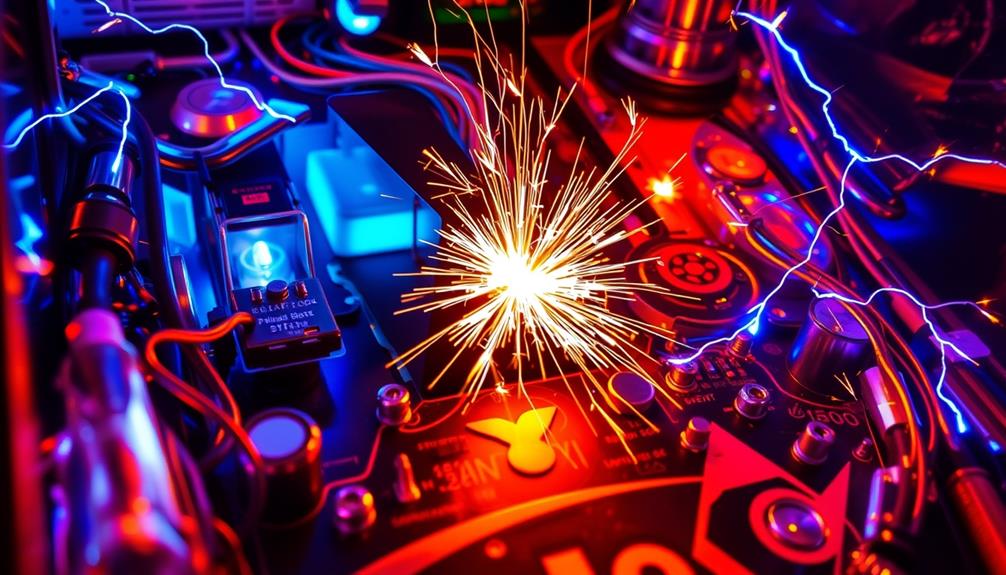
When powering on a pinball machine, you'll notice a significant initial surge of current known as inrush current. This surge can be much higher than the machine's normal operating current. For example, a 48V power supply may draw an inrush current of 20A at 115VAC and 40A at 230VAC.
Understanding the effectiveness of home security systems is essential for preventing potential overloads and ensuring reliable operation. Here are some key points to take into account:
- High inrush current must be factored into power supply selection.
- Proper management of inrush current helps avoid tripping circuit breakers during startup.
- Circuit designs should accommodate these temporary spikes.
- Monitoring inrush current values can improve overall system performance.
Cost of Operating Pinball Machines
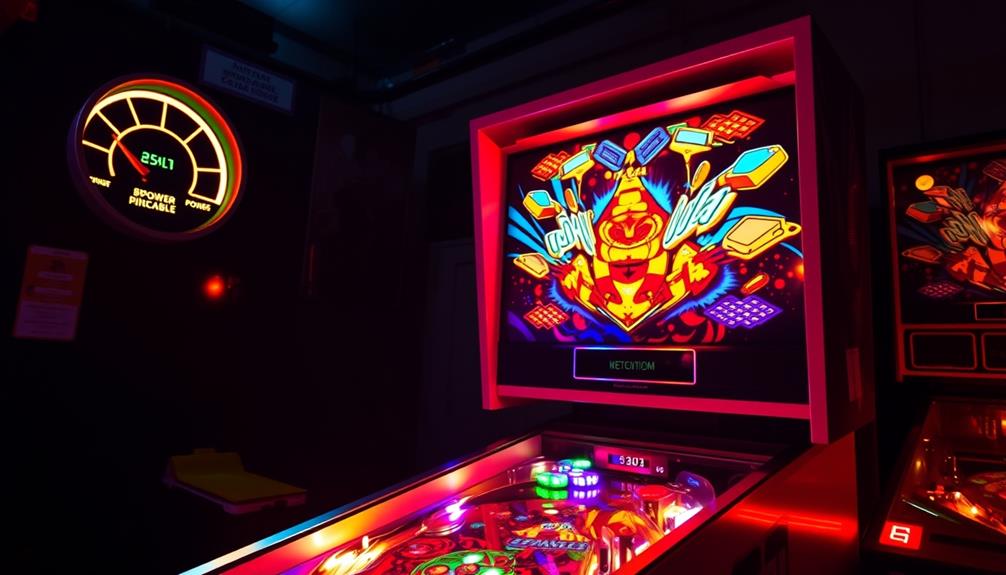
The cost of operating pinball machines can vary considerably based on their power consumption and usage patterns. With average power usage ranging from 245 to 350 watts, you can expect different costs depending on how you run your machines.
Here's a quick breakdown of typical operating costs:
| Machine Type | Cost per Day | Cost per Week |
|---|---|---|
| Standard (LED) | $0.576 | ~$4.032 |
| Standard (Incandescent) | Higher (varies) | Higher (varies) |
| Low Power Setup | Lower (5p/hour) | Minimal |
For example, operating two machines for 9 hours daily can cost around £5 per week. If you use LED lighting, the cost of play can drop to as low as 5p per hour, offering significant savings. Additionally, commercial operators find that running five pinball machines plus video games can cost about £10 for 13 hours of operation, highlighting the importance of efficient energy management. Overall, understanding the cost of operating these machines helps you make informed decisions on usage and maintenance.
Electrical Load Management

Effective electrical load management is essential for ensuring the smooth operation of pinball machines in any setting. By monitoring their power usage, you can prevent overloads and reduce your electric bill.
Understanding the significance of selecting the right cold medication can similarly help in managing health effectively, much like managing electrical loads.
Pinball machines typically consume between 245-350 watts, peaking at 600 watts, so it's crucial to understand your circuit capacity. Here are some key points to keep in mind:
- Use a power meter to track the real-time consumption of your machines.
- Stick to a maximum of four pinball machines on a 15A dedicated breaker.
- Regularly test circuit capacity to avoid tripping breakers.
- Be aware that high-demand games may draw more current during gameplay than during idle modes.
Community Insights on Power Usage

Pinball enthusiasts frequently share valuable insights on power usage, helping operators optimize their machines' efficiency. One of the standout recommendations is to replace incandescent bulbs with LEDs, which can enhance the overall ambiance of your game area while also being energy-efficient.
Many users report that switching to LEDs can drastically reduce power consumption. For instance, some pinball machines see their current draw drop from 2.1 amps to as low as 0.67 amps. This not only lowers electricity costs but also extends the life of your machine.
Innovative coffee gear can similarly elevate the brewing experience.
In attract mode, machines typically draw around 100-120 watts when equipped with LEDs. This increases to about 150 watts during gameplay. Operators should keep an eye on these changes, as the average power consumption during gameplay is around 300 watts.
Community feedback emphasizes that monitoring power usage is essential. For example, if you leave two machines on for 9 hours daily, you could spend about £5 weekly on electricity.
Frequently Asked Questions
What Is the Voltage of a Pinball Machine?
A pinball machine typically operates on a 120V AC voltage supply for its components. It also uses 12V and 48V DC supplies for electronic elements and motors, ensuring all specs meet manufacturer requirements.
What Voltage Is a Pinball LED?
Pinball LED bulbs typically operate at either 12V or 6V, depending on your machine's requirements. Make certain you match the voltage to avoid damaging the LEDs and guarantee they function properly in your game.
Is Pinball Good for the Brain?
Yes, pinball's great for your brain! It sharpens your reflexes, boosts problem-solving skills, and enhances spatial awareness. Plus, playing with friends fosters social interaction, improving communication and teamwork while providing stress relief. Enjoy the benefits!
How to Transport a Pinball Machine?
Did you know pinball machines can weigh over 200 pounds? When transporting one, always unplug it, use a padded dolly, and secure it upright. Protect the glass with bubble wrap for extra safety during transit.
Conclusion
In summary, understanding a pinball machine's power consumption is essential for any enthusiast or operator. Did you know that a typical pinball machine can consume anywhere from 50 to 400 watts, depending on its features? This means that over time, the costs can add up, especially with machines featuring LED lighting. By managing electrical loads wisely, you can enjoy your games without breaking the bank. So, keep an eye on that power usage to maximize your fun!
